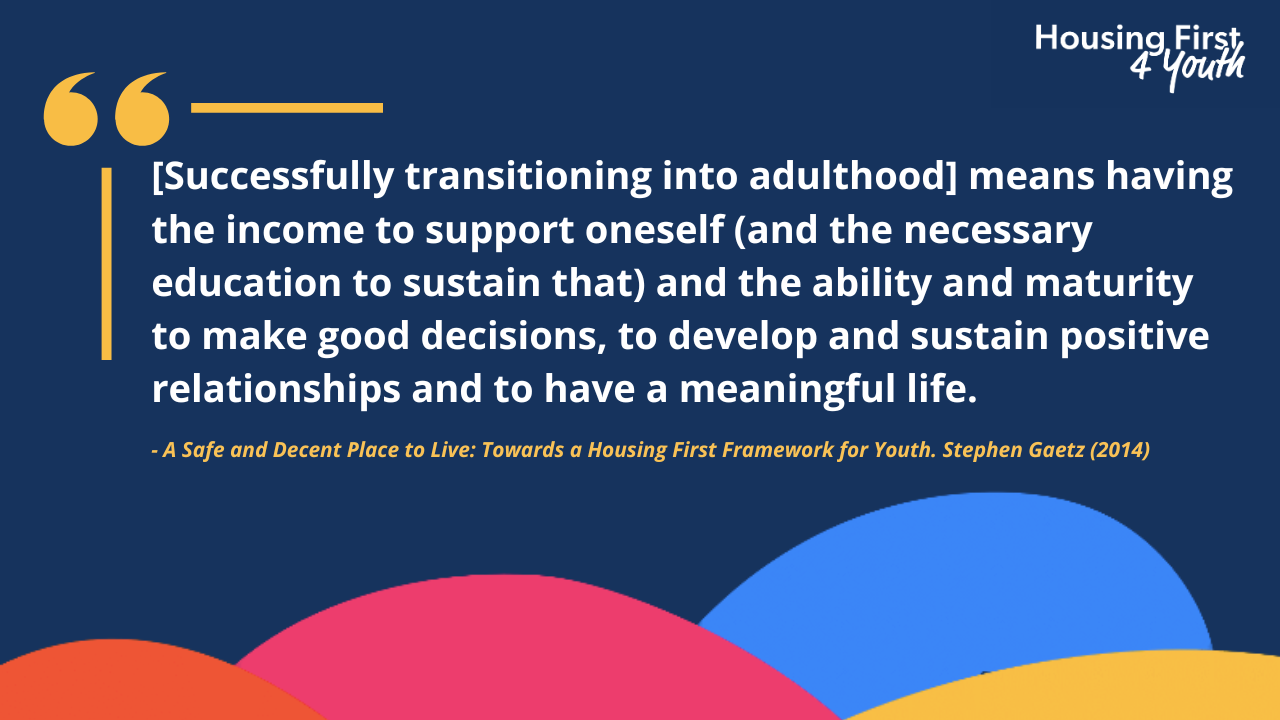What is HF4Y?
Housing First for Youth (HF4Y) is a rights-based intervention for young people (aged 13-24) who are at risk of or experiencing homelessness. The goal of HF4Y is not simply to provide housing stability, but to support young people holistically and facilitate a healthy transition to adulthood.
HF4Y programs must provide supports in addition to housing. These additional supports help youth to strengthen their sense of belonging and self-identity, connect them to community and assist in rebuilding and developing their relationships with family and natural supports. Having opportunities to connect to spiritual and cultural guidance, employment assistance, and clinical support is also required as one of the core principles of Housing First for Youth.
Housing and supports that are designed for adults but used to support young people CANNOT be considered HF4Y. These services do not consider young peoples’ stages of development and the unique challenges that come with early adulthood. Services that are not adapted for youth often place too much emphasis on “independence” and self-sufficiency at the expense of providing the necessary supports to assist young people through this phase of life:

Housing options are also a key component to the HF4Y model. Housing needs of young people change over time, depending on their stage of development, life skills, ability, and income. Therefore, the supports and housing options offered to young people must have some variety, providing a range of options that can be tailored to unique circumstances.
This blog will discuss examples of housing options that can be adapted to meet the principles of HF4Y.
Housing Options that Can be Adapted for HF4Y Principles
1) RETURNING HOME
The ideal outcome for many young people is that they return home or identify a caring adult or natural support they can live with. This can be achieved through interventions and services that enhance and strengthen family and natural supports (FNS) such as family reconnection and mediation.
2) HOST HOMES
“Host Homes” are a short-term accommodation style designed to support young people while long-term housing is being arranged. For example, a young person may stay in their community with a Host Home provider and receive case management support as an alternative to accessing emergency shelters.
Host Homes can be used when young people and their families need space from each other to work through conflicts, or when the home environment may be unsafe for the youth to return and other housing options need to be explored
3) TRANSITIONAL HOUSING
Actual living arrangements within a transitional housing model can vary, but key examples are highlighted below.
Foyers offer an integrated living model where young people are housed for a longer period than is typical. This living model ensures that youth are supported to grow and practice their living skills. There is an intentional focus on education, training, and employment. One example of Foyers is the Haven’s Way program in Calgary, Alberta.
Shared Accommodations models also provide an interesting approach. In the first stage, young people live in settings where they share living space (separate bedrooms but shared cooking and living spaces). In the second stage, young people may move into separate bachelor apartments within the same facility. This allows young people to transition to independent living in a supportive environment.
Another example of transitional housing originates from Denmark, where a certain number of rooms within university/college dorms are allocated to youth that have experienced homelessness. This provides them with a positive peer environment that can eventually lead to independent living.
There are two major considerations for including transitional housing in HF4Y housing continuum.
First, no time limits should be placed on youth for when they are ready and able to live on their own. There is not a lot of strong evidence which suggests that time-limited transitional housing results in positive outcomes for young people, and this may be due to young people being forced to leave before they are ready.
Second, young people who choose such accommodations must have ongoing access to their supports and support worker when they feel ready to move into independent living. In cases where young people do have to move – or choose to – they must retain case management/housing supports in their new home for as long as they need until they feel comfortable living independently.
4) INDEPENDENT LIVING IN SCATTERED-SITE HOUSING
This is the model of accommodation that is most closely aligned to the Housing First for Youth Model and its core principles.
Independent living refers to situations where young people obtain and maintain their own or shared permanent housing in either the private market or the social housing sector. Depending on the needs and desires of the young person, they should have access to a range of services and supports including reconnection and development of family and natural supports.
The success of the Infinity Project in Calgary demonstrates that this model can be successful for young people.
In a HF4Y context, what kinds of housing are appropriate?
A core principle of HF4Y is Youth Choice, Youth Voice, and Self-Determination. This principle emphasizes that young people should have a say as to what kind of housing they receive and where it is located.
In a HF4Y program, independent living is typically considered the ideal outcome for all young people and is the preferred option for young people experiencing homelessness. However, the developmental needs of young people and local rental laws may present some challenges. For example, some jurisdictions do not allow landlords to rent to minors. For these reasons, it is important for agencies to remove barriers for young people and strive to offer a range of housing options that are suitable for young people.
In contexts where housing options and systems of supports are less developed, young people may be referred to other kinds of housing options (e.g., transitional housing) while remaining within a HF4Y program, as long as the following conditions are met:
- The young person has real options and makes an informed decision to participate in the alternative housing program.
- They remain part of the Housing First program on the caseload of a HF4Y worker, even while residing in a housing program that comes with supports and potentially conditions (this is with the understanding and consent of the young person).
- They are provided with support for accessing other kinds of housing – in particular, independent living – when they leave the program. In other words, they cannot lose their housing and supports when their tenure in the housing program ends.
- There is a clear pathway for HF4Y clients to eventually move into and sustain independent living accommodations.
Finally, emergency shelters should be the very last resort to housing young people due to the risks of exposure to trauma and exploitation in drug and sex trafficking.
To learn more about Housing First for Youth and how you can implement it in your community, check out the free program model guide: https://www.homelesshub.ca/HF4Y
To learn more about training and technical assistance contact: info@awayhomecanada.ca




